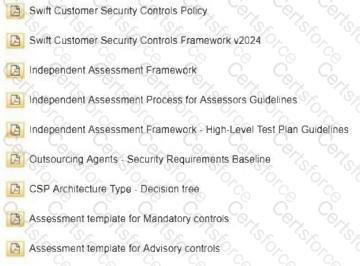This question addresses valid implementations ofControl 2.9: Transaction Business Controlsunder theSwift Customer Security Controls Framework (CSCF) v2024, which focuses on detecting and preventing fraudulent transactions.
Step 1: Understand Control 2.9 Transaction Business Controls
Control 2.9 requires Swift users to implement measures to validate transaction flows against expected business patterns, aiming to detect anomalies that could indicate fraud or error. TheCSCF v2024emphasizes flexibility in implementation, provided the controls mitigate identified risks effectively.
Step 2: Evaluate Each Option
A. Multiple measures must be implemented by the Swift user to validate the flows of transactions are in the bounds of the normal expected businessTheCSCF v2024, underControl 2.9, mandates the use of multiple detection measures (e.g., transaction monitoring, threshold limits, anomaly detection) to ensure transaction flows align with normal business expectations. This multi-layered approach is essential to address diverse fraud risks.Conclusion: This is correct.
B. A customer designed implementation or a combination of different measures are deemed valid if they sufficiently mitigate the control risksTheCSCF v2024allows flexibility in how users implement Control 2.9, permitting custom solutions or combinations of measures (e.g., AI-based monitoring, manual reviews) as long as they effectively mitigate the risks identified in the user’s risk assessment. This is supported by theSwift CSP FAQon control customization.Conclusion: This is correct.
C. Reliance on a recent business assessment or regulator response confirming the effectiveness of the control (as an example CPMI's requirement) is especially poignant to this controlWhile a business assessment or regulator input (e.g., CPMI-IOSCO guidelines) can inform the implementation, Control 2.9 requires the user to implement specific measures, not just rely on external validations. TheCSCF v2024does not allow sole dependence on such assessments; users must demonstrate their own controls.Conclusion: This is incorrect.
D. Any solution is acceptable so long as the CISO approves the implementationTheCSCF v2024requires that implementations meet objective criteria for risk mitigation, not just internal approval by the Chief Information Security Officer (CISO). The independent assessment must validate effectiveness, not just rely on CISO endorsement.Conclusion: This is incorrect.
Step 3: Conclusion and Verification
The verified answers areAandB, as they align with the requirements and flexibility ofControl 2.9 Transaction Business Controlsin theCSCF v2024, ensuring robust and tailored transaction validation.
References
Swift Customer Security Controls Framework (CSCF) v2024, Control 2.9: Transaction Business Controls.
Swift CSP FAQ, Section: Control Implementation Flexibility.
Swift Security Best Practices, Section: Transaction Monitoring.

Submit